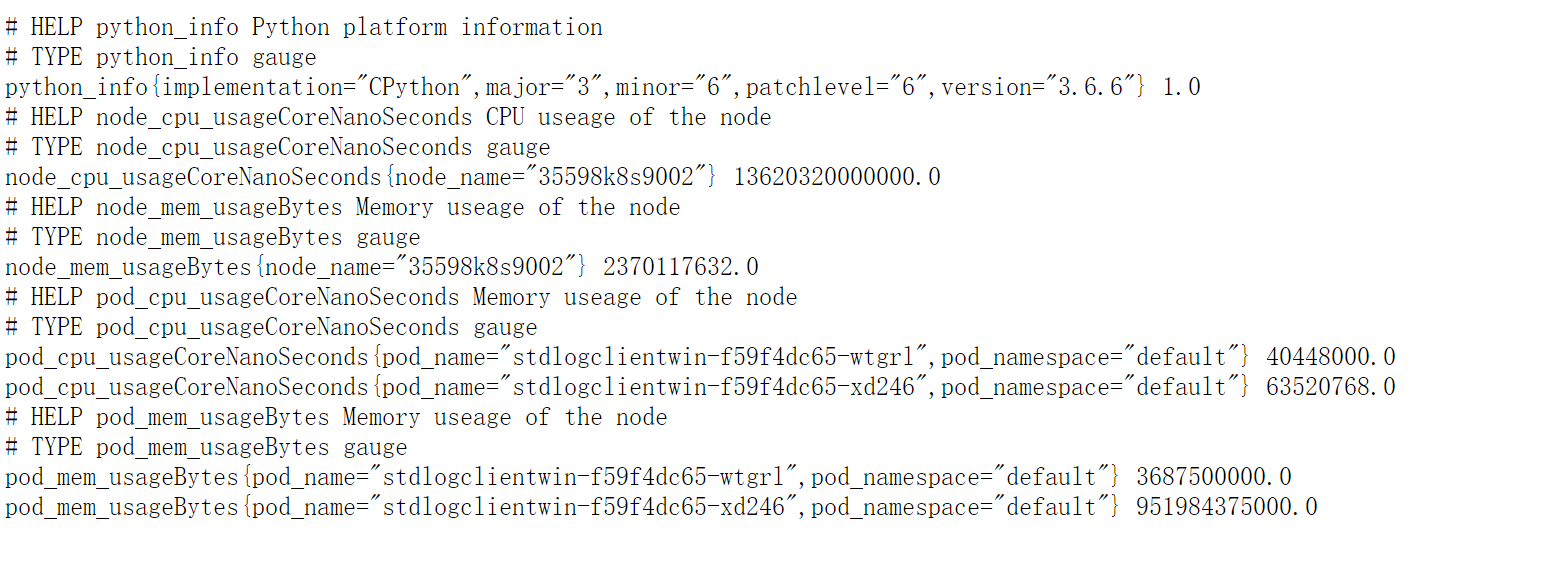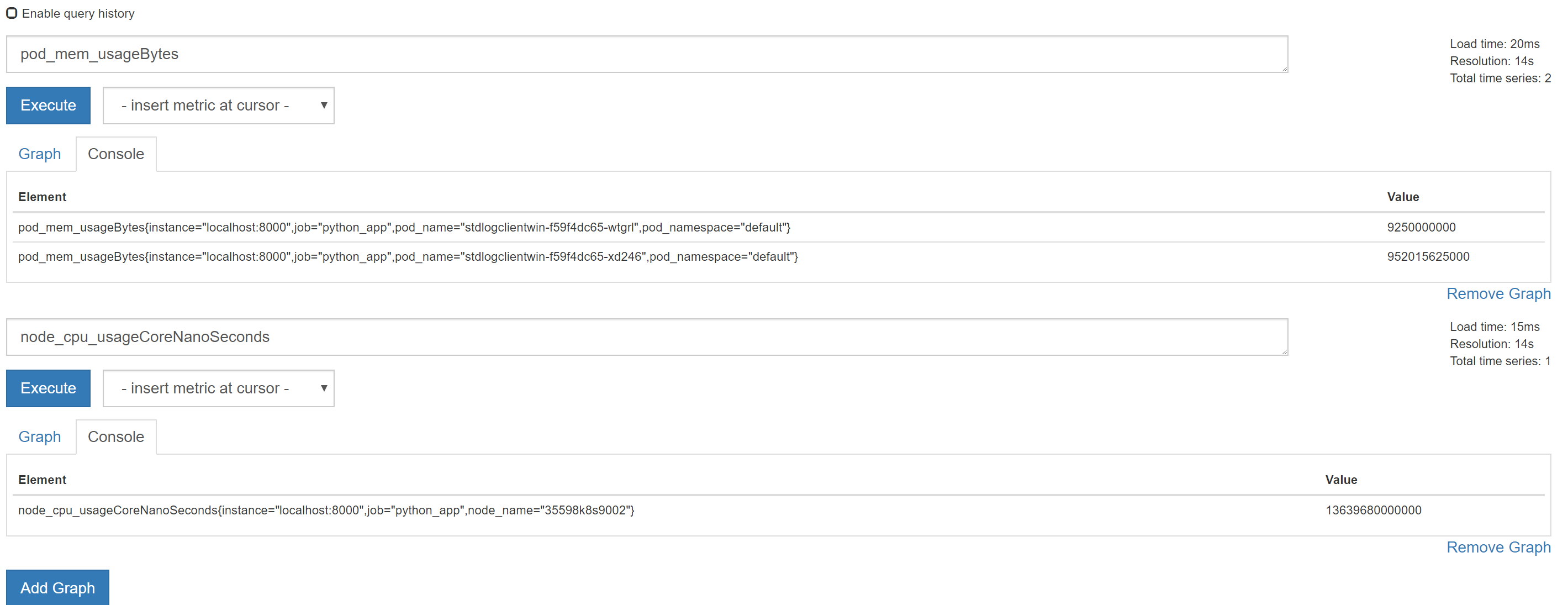解決 Prometheus 不能獲取 Kubernetes 叢集上 Windows 節點的 Metrics
阿新 • • 發佈:2018-12-12
背景
接上一篇 快速搭建 Windows Kubernetes , 我們發現原來在 Windows Kubernetes 會有一些與在 Linux 上使用不一樣的體驗,俗稱坑,例如 hostAliases。對於我們希望真的把 Windows 放入生產,感覺除了基本的 Pod、Volume、Service 、Log 以外,我們還需要監控。一般來講我們會用 Prometheus 來做監控,然後通過 Grafana 來展示,但是 Prometheus 的 Node Exporter 是為 *nix 設計的,所以在 Windows 上我們的自己想辦法了。在 Prometheus Node Exporter 裡推薦使用 WMI exporter ,感興趣的童鞋可以去試試,本文主要還是想從一個原始的角度去分析處理,來理解怎麼去寫一個 Prometheus 的採集程式。
前提
- 一套 Windows Kuberentes
- 一個 Prometheus 環境
步驟
- 首先得找到 Kubelet 在 Windows 上暴露出來得資料格式, 因為 cadivsor 並不支援 Windows, 社群有位同志寫了一個相對簡單的實現來支援; 他這個的實現還是保持 Linux 上的一樣,是從
<Node_IP>:10255/stats/summary上 expose metrics, metrics-server 與kubectl top的資料也是來源於此,大致如下:
{ "node": { "nodeName": "35598k8s9001", "startTime": "2018-08-26T07:25:08Z", "cpu": { "time": "2018-09-10T01:44:52Z", "usageCoreNanoSeconds": 8532520000000 }, "memory": { "time": "2018-09-10T01:44:52Z", "availableBytes": 14297423872, "usageBytes": 1978798080, "workingSetBytes": 734490624, "rssBytes": 0, "pageFaults": 0, "majorPageFaults": 0 }, "fs": { "time": "2018-09-10T01:44:52Z", "availableBytes": 15829303296, "capacityBytes": 32212250624, "usedBytes": 16382947328 }, "runtime": { "imageFs": { "time": "2018-09-10T01:44:53Z", "availableBytes": 15829303296, "capacityBytes": 32212250624, "usedBytes": 16382947328, "inodesUsed": 0 } } }, "pods": [ { "podRef": { "name": "stdlogserverwin-5fbcc5648d-ztqsq", "namespace": "default", "uid": "f461a0b4-ab36-11e8-93c4-0017fa0362de" }, "startTime": "2018-08-29T02:55:15Z", "containers": [ { "name": "stdlogserverwin", "startTime": "2018-08-29T02:56:24Z", "cpu": { "time": "2018-09-10T01:44:54Z", "usageCoreNanoSeconds": 749578125000 }, "memory": { "time": "2018-09-10T01:44:54Z", "workingSetBytes": 83255296 }, "rootfs": { "time": "2018-09-10T01:44:54Z", "availableBytes": 15829303296, "capacityBytes": 32212250624, "usedBytes": 0 }, "logs": { "time": "2018-09-10T01:44:53Z", "availableBytes": 15829303296, "capacityBytes": 32212250624, "usedBytes": 16382947328, "inodesUsed": 0 }, "userDefinedMetrics": null } ], "cpu": { "time": "2018-08-29T02:56:24Z", "usageNanoCores": 0, "usageCoreNanoSeconds": 749578125000 }, "memory": { "time": "2018-09-10T01:44:54Z", "availableBytes": 0, "usageBytes": 0, "workingSetBytes": 83255296, "rssBytes": 0, "pageFaults": 0, "majorPageFaults": 0 }, "volume": [ { "time": "2018-08-29T02:55:16Z", "availableBytes": 17378648064, "capacityBytes": 32212250624, "usedBytes": 14833602560, "inodesFree": 0, "inodes": 0, "inodesUsed": 0, "name": "default-token-wv5fc" } ], "ephemeral-storage": { "time": "2018-09-10T01:44:54Z", "availableBytes": 15829303296, "capacityBytes": 32212250624, "usedBytes": 16382947328 } } ] }
- 從上面可以看到,它包含了本機和 pod 的一些 metrics, 相對 cadvisor 能提供的少了一些,但是基本監控是沒問題的。接下來我們需要寫一個小程式把資料轉換成 Prometheus 能解析的資料。接下來用 python 寫個小栗子, 先宣告下我們要 expose 的 stats 物件
class Node:
def __init__(self, name, cpu, memory):
self.name = name
self.cpu = cpu
self.memory = memory
class Pod:
def __init__(self, name, namespace,cpu, memory):
self.name = name
self.namespace = namespace
self.cpu = cpu
self.memory = memory
class Stats:
def __init__(self, node, pods):
self.node = node
self.pods = pods- 使用 Prometheus 的 python-client 來寫一個 polling 的程式,去轉換 kubelet stats 資料。
from urllib.request import urlopen
from stats import Node
from stats import Pod
from stats import Stats
import json
import asyncio
import prometheus_client as prom
import logging
import random
def getMetrics(url):
#獲取資料集
response = urlopen(url)
string = response.read().decode('utf-8')
json_obj = json.loads(string)
#用之前定義好的 stats 的物件來做 mapping
node = Node('','','')
node.name = json_obj['node']['nodeName']
node.cpu = json_obj['node']['cpu']['usageCoreNanoSeconds']
node.memory = json_obj['node']['memory']['usageBytes']
pods_array = json_obj['pods']
pods_list = []
for item in pods_array:
pod = Pod('','','','')
pod.name = item['podRef']['name']
pod.namespace = item['podRef']['namespace']
pod.cpu = item['cpu']['usageCoreNanoSeconds']
pod.memory = item['memory']['workingSetBytes']
pods_list.append(pod)
stats = Stats('','')
stats.node = node
stats.pods = pods_list
return stats
#寫個簡單的日誌輸出格式
format = "%(asctime)s - %(levelname)s [%(name)s] %(threadName)s %(message)s"
logging.basicConfig(level=logging.INFO, format=format)
#宣告我們需要匯出的 metrics 及對應的 label 供未來查詢使用
g1 = prom.Gauge('node_cpu_usageCoreNanoSeconds', 'CPU useage of the node', labelnames=['node_name'])
g2 = prom.Gauge('node_mem_usageBytes', 'Memory useage of the node', labelnames=['node_name'])
g3 = prom.Gauge('pod_cpu_usageCoreNanoSeconds', 'Memory useage of the node', labelnames=['pod_name','pod_namespace'])
g4 = prom.Gauge('pod_mem_usageBytes', 'Memory useage of the node', labelnames=['pod_name','pod_namespace'])
async def expose_stats(url):
while True:
stats = getMetrics(url)
#以列印 node 本身的監控資訊為例
logging.info("nodename: {} value {}".format(stats.node.name, stats.node.cpu))
# 為當前要 poll 的 metrics 賦值
g1.labels(node_name=stats.node.name).set(stats.node.cpu)
g2.labels(node_name=stats.node.name).set(stats.node.memory)
pods_array = stats.pods
for item in pods_array:
g3.labels(pod_name=item.name,pod_namespace=item.namespace).set(item.memory)
g4.labels(pod_name=item.name,pod_namespace=item.namespace).set(item.cpu)
await asyncio.sleep(1)
if __name__ == '__main__':
loop = asyncio.get_event_loop()
# 啟動一個 http server 來做 polling
prom.start_http_server(8000)
t0_value = 50
#可以在每一臺 Windows 機器上都啟動一個這樣的程式,也可以遠端部署指令碼來做 exposing
url = 'http://localhost:10255/stats/summary'
tasks = [loop.create_task(expose_stats(url))]
try:
loop.run_forever()
except KeyboardInterrupt:
pass
finally:
loop.close()- 寫完以後就可以啟動這個程式了,訪問他的 8000 埠就能看到相關的資料

- 接下來需要在 prometheus 里加入配置,增加一個收集物件,如下例:
- job_name: python_app
scrape_interval: 15s
scrape_timeout: 10s
metrics_path: /
scheme: http
static_configs:
- targets:
- localhost:8000- 這樣在 Prometheus 的頁面上能查詢到相關的資訊了

提問?
- kubelet 返回的
usageNanoCores和usageCoreNanoSeconds怎麼換算成我們通常理解的 CPU 使用百分比
Ref:
